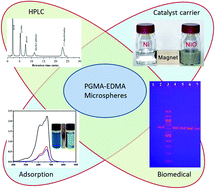Microporous poly(glycidyl methacrylate-co-ethylene glycol dimethyl acrylate) microspheres: synthesis, functionalization and applications
Abstract
As a new kind of functional material, micron-sized porous polymer microspheres are a hot research topic in the field of polymer materials. Poly(glycidyl methacrylate)microspheres have been widely used in many fields, such as immobilization of bioactive substances (enzymes, cells, proteins, antibodies, etc.). There are three main preparation methods of PGMA microspheres: suspension polymerization, the seed expansion method, and precipitation polymerization. By introducing different functional groups into microspheres, the hydrophobicity, solubility and biocompatibility of the microspheres were improved, and the microspheres with different characteristics could be applied as high performance chromatographic fillers and catalyst carriers and in biomedical and adsorbent fields. In this paper, the development history, preparation methods, functionalization and application of poly(GMA-co-EGDMA) composite microspheres are reviewed systematically and comprehensively. Finally, the existing application materials based on PGMA microspheres are summarized and analyzed, and the application prospect of poly(GMA-co-EGDMA) composite microspheres in the future is analyzed.



 Please wait while we load your content...
Please wait while we load your content...